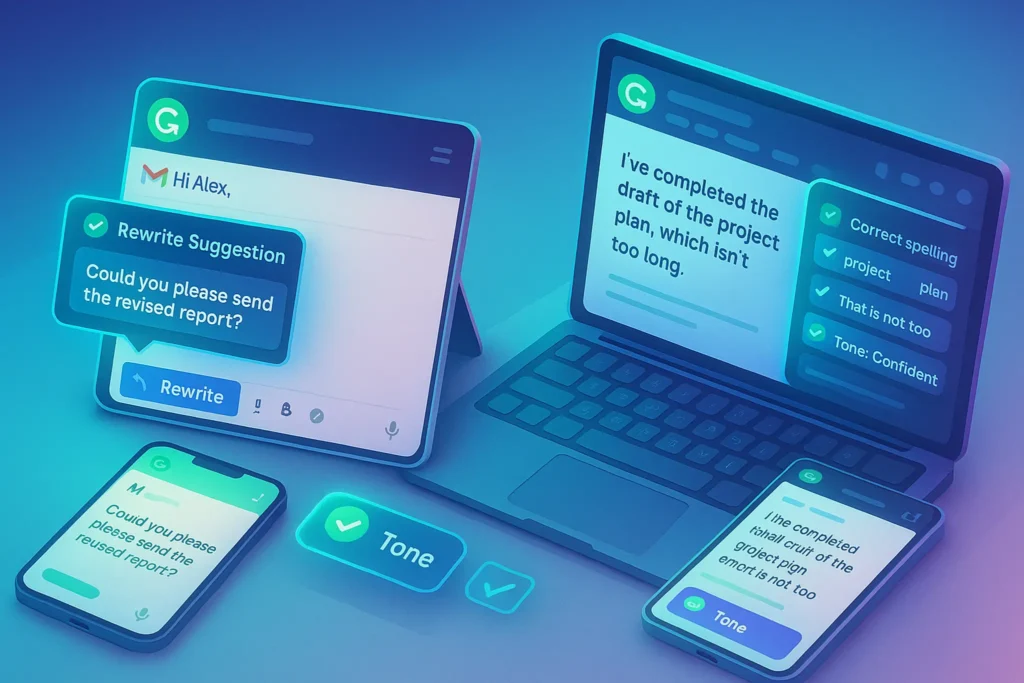-This post may contain affiliate links. If you click on one and make a purchase, I may earn a small commission at no extra cost to you.-
Introduction: Grammarly in 2025—Still the Best in Class?
Grammarly has been around for over a decade—and in the world of AI writing tools, that’s practically ancient. But with shiny new competitors entering the scene every year, the big question is:
Does Grammarly still deliver real value in 2025?
We tested Grammarly across real-world writing scenarios—from formal emails to blog posts, tweets, and essays—to find out whether it truly improves your writing… or just makes you feel better about it.
🧪 Real-World Testing Scenarios: Does It Actually Help?
To test Grammarly honestly, we used it in four live writing contexts:
💼 1. Business Email
Grammarly helped us rewrite a slightly awkward email pitch into something more polished and professional.
✅ Corrected grammar and softened tone with suggestions like:
“We hope this finds you well” → “I hope you’re doing well”
🧠 Nerd Verdict: Useful, especially when writing under pressure or fatigue.
📄 2. Essay & Longform Content
In a 1000-word academic-style draft, Grammarly:
-
Spotted 12 grammar issues (mostly passive voice and unclear sentences)
-
Suggested trimming 140 words for conciseness
-
Flagged overly complex phrasing with tone correction
⚠️ It struggled with domain-specific phrases like “epistemic relevance”—trying to simplify it awkwardly.
✍️ 3. Blog Post
We wrote a blog draft in a casual tone. Grammarly:
-
Preserved the tone well
-
Helped with comma placement and fluidity
-
Offered alternative word choices without killing the voice
This is where Grammarly shines—supporting style without enforcing rigid “rules.”
📢 4. Social Media Caption
Short captions are tricky. Grammarly offered tone checks like:
“Maybe this will work?” → “This might be the solution you’re looking for!”
Sometimes helpful, sometimes… robotic.
🧠 Micro-UX Prompt: Did it improve our writing?
Yes—for structure, flow, and polish. But it still requires human judgment to avoid sounding over-edited.
✍️ Core Features Overview: What Does Grammarly Actually Do?
Grammarly isn’t just a spell checker anymore. In 2025, it’s a multi-layered writing assistant with features split across its Free and Premium tiers:
🔹 Free Plan Covers:
-
Grammar and punctuation corrections
-
Basic spelling checks
-
Conciseness suggestions
-
Tone detector (limited)
🔸 Premium Plan Adds:
-
Full-sentence rewrites
-
Vocabulary enhancements
-
Formality & fluency suggestions
-
Plagiarism detection
-
Citation generation (APA, MLA, Chicago)
One of the most useful additions in recent years is the Citation Tool, which makes it easy for students and academic writers to automatically generate proper citations from URLs, DOIs, or titles.
If you’re a student or academic, Grammarly’s citation tool can complement your AI note-taking workflow especially when paired with tools like Zotero or Notion.
📊 Quick-Feature Snapshot Table (Free vs Premium)
| Feature | Free Version | Premium Version |
|---|---|---|
| Grammar + Spelling | ✅ | ✅ |
| Clarity & Tone | ⚠️ Basic | ✅ Advanced |
| Vocabulary Suggestions | ❌ | ✅ |
| Sentence Rewriting | ❌ | ✅ |
| Plagiarism Checker | ❌ | ✅ |
| Citation Generator | ❌ | ✅ |
🧠 AI-Powered Suggestions: How Smart Is Grammarly in 2025?
Grammarly’s AI engine has evolved—significantly. The platform now uses a transformer-based model to understand context, tone, and intention beyond basic grammar rules.
But does it really “get” what you’re trying to say?
✅ Where It Excels:
-
Clarity rewrites that often feel like a good editor’s advice
-
Smart detection of tone mismatches (e.g., too blunt in an email)
-
Vocabulary refinement without over-complicating the text
⚠️ Where It Still Fails:
-
Occasionally offers passive-to-active voice changes that feel forced or grammatically off
-
In longer pieces, it may over-simplify complex writing, especially academic or technical
-
Sometimes misinterprets sarcasm, humor, or regional expressions
We gave Grammarly a sarcastic tweet to evaluate:
“Oh sure, because everyone loves a three-hour Zoom meeting 🙄”
It suggested:
“Everyone enjoys a lengthy Zoom meeting.” 😐
Clearly not the vibe.
🎯 So is it indistinguishable from a real human editor?
Not quite—but it’s close enough to assist daily writing, and way better than browser spellcheck.
Compared to tools like Wordtune or QuillBot, Grammarly’s suggestions feel more context-aware—though still not on the same level as full AI co-writers like ChatGPT. If you’re comparing tools, check our Best AI Writing Assistants post for the full breakdown.
🌐 Integration & UX: How Seamless Is Grammarly Across Devices?
Grammarly has built one of the most ubiquitous writing layers across modern digital workflows.
You’ll find Grammarly in:
-
✅ Chrome & Edge browser extensions
-
✅ Native desktop apps (macOS, Windows)
-
✅ Microsoft Word & Outlook plugin
-
✅ Google Docs native integration
-
✅ Mobile keyboard app (iOS & Android)
Across platforms, the UI remains minimal yet powerful—non-intrusive, with underlined suggestions that pop up only when needed. The experience feels consistent, with fast syncing across devices.
That said, there are nuances:
✏️ Gmail / Google Docs:
Grammarly works natively in Gmail and integrates tightly into Google Docs. It handles paragraph edits smoothly, but occasionally causes slowdowns on long docs with lots of suggestions.
🖥️ Desktop App:
Ideal for longer writing—like essays, reports, or manuscript edits. The distraction-free environment and document history make it more than just a plugin.
📱 Mobile Keyboard:
Useful for social posts, texts, and email. However, it’s not as robust as desktop—some suggestions lag or miss tone cues.
For users who switch between phone, laptop, and web platforms, Grammarly’s cross-platform consistency is a huge plus. This is one area where it beats lighter tools like QuillBot or Wordtune.
📊 UX Smoothness Score Across Platforms
| Platform | Score (Out of 10) | Notes |
|---|---|---|
| Gmail Integration | 9 | Seamless for emails |
| Google Docs | 8 | Occasional lag on long documents |
| Desktop App | 9.5 | Best experience for longform writing |
| Mobile App | 7.5 | Useful but sometimes buggy |
| Microsoft Word | 9 | Mature integration |
💸 Pricing & Plans: What Do You Actually Pay For?
Grammarly offers a freemium model with decent functionality—but the real power is unlocked in Premium.
Plans (as of mid-2025):
-
Free: Grammar, spelling, basic tone
-
Premium: $12/month (billed annually)
-
Business: $15/user/month, includes team analytics & style guides
For the features you get—plagiarism check, citation tool, full rewrites—the Premium plan feels reasonably priced, especially compared to hiring an editor or coach.
Now, how does it compare to its competitors?
🧪 Grammarly vs. Human Editor: Can It Compete?
To test Grammarly’s real-world effectiveness, we gave the same 300-word rough draft to:
-
Grammarly Premium
-
A freelance professional editor
-
A control group (no edits)
✍️ Original Excerpt (Sample):
Our product was released last year. Since then, it seen many usecases. Some customers happy, some not. Feedback been all over. But in future we want fix issue, and make things more better for users.
💻 Grammarly Output:
Our product was released last year. Since then, it has seen many use cases. Some customers were happy, others were not. Feedback has been mixed. In the future, we aim to fix issues and improve the user experience.
✅ Clean, readable, grammatically correct
⚠️ Still a bit robotic—flat tone, generic
✍️ Human Editor Version:
After launching last year, our product has been adopted in a wide range of use cases. While many customers are satisfied, others have shared valuable critiques. We’re committed to learning from all feedback and improving the experience moving forward.
✅ Fluent, natural flow
✅ Improved tone, engagement
✅ Clear message with intentional structure
Nerd Verdict: Grammarly is excellent for fixing mistakes—but not for elevating writing to a persuasive, human level. A real editor brings nuance, strategy, and style—something Grammarly still lacks.
🧩 Use-Case Layering: How Different Users Actually Use Grammarly
Grammarly isn’t a one-size-fits-all tool. Its value depends heavily on who’s using it—and why.
👨🎓 ESL Student (English as Second Language)
Struggles with grammar, article usage, and sentence structure.
-
Grammarly helps catch repeated mistakes
-
Tone detector boosts writing confidence
-
Citation tool simplifies formatting for academic papers
“I don’t worry about losing points on grammar anymore.”
✍️ Freelance Web Copywriter
Writes landing pages, blog posts, and email copy under deadlines.
-
Uses Grammarly for quick error checks before client delivery
-
Sentence rewrite tool helps polish key CTA lines
-
Tone suggestions useful for brand voice adjustment
“It’s like having a junior editor double-check everything.”
🧑💼 Marketing Manager
Handles external communication, team announcements, and reports.
-
Uses Grammarly in Gmail + Google Docs
-
Relies on tone adjustments to avoid sounding too harsh or robotic
-
AI summarizer helps in repackaging content for newsletters
“It reduces friction in internal reviews—and saves time.”
🧑🏫 Educator / Academic
Prepares course materials, feedback, and publishes research
-
Uses Grammarly for clarity and formatting
-
Finds plagiarism checker helpful when reviewing student work
-
Minor trust issues with AI suggestions on complex writing
“It’s good—but I still prefer my own judgment on technical writing.”
📉 Where Grammarly Still Fails: Know Before You Over-Rely
Even with years of updates and AI enhancements, Grammarly still has blind spots—and it’s important to know them.
⚠️ 1. Humor & Irony
Grammarly often misunderstands sarcasm, wit, or tone subtleties. It may recommend tone changes that ruin your intent.
Example:
“I just love getting last-minute revisions 😒”
Grammarly rewrites it into a serious-sounding sentence, killing the effect.
⚠️ 2. Idioms & Cultural Nuance
Phrases like “hit the ground running” or “bend over backwards” are sometimes flagged or “corrected” into something awkward or literal.
For ESL users, this could be misleading.
⚠️ 3. Multi-Paragraph Context
Grammarly operates on a sentence-by-sentence or paragraph-by-paragraph basis. It lacks memory across larger sections.
Example: If you hint at an idea in paragraph 2 and reference it again in paragraph 5, Grammarly might suggest removing or “clarifying” both—without realizing they’re connected.
⚠️ 4. Creative or Fiction Writing
Writers using unusual sentence structures, stylized prose, or experimental formatting will find Grammarly too rigid. It may fight against deliberate choices.
TL;DR: Grammarly is a brilliant assistant, but it’s not your writing brain. Knowing when to trust it—and when to ignore it—is what separates good writing from over-edited, lifeless copy.
📊 Grammarly vs ProWritingAid vs QuillBot
| Feature | Grammarly | ProWritingAid | QuillBot |
|---|---|---|---|
| Grammar & Spelling | ✅ Smart & Fast | ✅ Deep Ruleset | ✅ Basic AI |
| Sentence Rewriting | ✅ (Premium) | ⚠️ Limited Context | ✅ Paraphrasing |
| Plagiarism Checker | ✅ (Premium) | ✅ (Premium) | ❌ (No native) |
| Citation Tool | ✅ | ❌ | ❌ |
| UI/UX | ✅ Polished | ⚠️ Outdated | ✅ Lightweight |
| Mobile Experience | ✅ Full Keyboard | ⚠️ Web only | ✅ Chrome + Web |
Grammarly is the most balanced tool for everyday users, while ProWritingAid may appeal more to editors or researchers, and QuillBot shines for paraphrasing tasks.
🧠 Nerd Verdict: Still a Must-Have or Just Comfort Software?
We’ve used Grammarly extensively across dozens of real scenarios—and here’s the honest takeaway:
✅ Grammarly Premium is absolutely worth it if:
-
You write regularly in a professional or academic context
-
English isn’t your first language
-
You need consistent tone, clarity, and flow in your content
-
You want to feel confident clicking “Send” or “Publish”
⚠️ It’s not magic. It won’t think for you or replace a great editor.
But it will catch what your brain skips over, and often make smart tone, structure, and polish suggestions that elevate your writing—without making it feel robotic.
So, do we still use it in 2025?
Yes. Every day. Not because we can’t write without it—but because it catches what we miss.
❓ FAQ: Nerds Ask, We Answer
💬 Would You Bite?
Have you ever used Grammarly—or another AI writing assistant?
Does it actually help you write better… or just make you feel safer?
👇 Drop your thoughts in the comments—#TeamEditor or #TeamAI?



